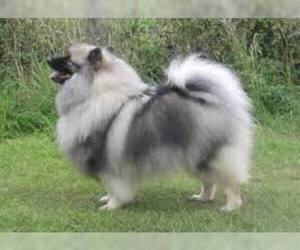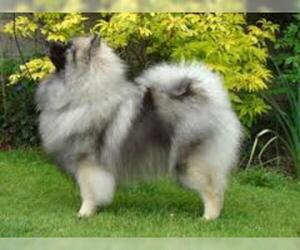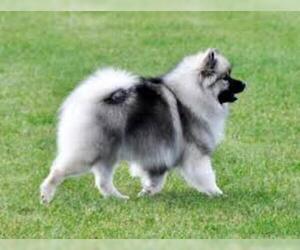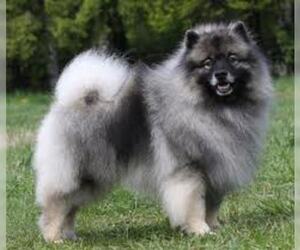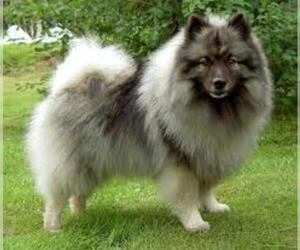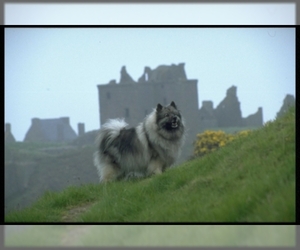
All about Keeshond dog breed
A.K.A. :Wolfspitz, Dutch Barge Dog, Smiling Dutchman, Deutscher Wolfsspitz, Chien Loup, Keeshondje, The Barking Cloud, Fuzzy Clown, Big Spitz, Little Wolf
Size
Grooming requirements
Exercise requirements
Good with other dogs
Watchdog ability
Energetic
Training requirements
Playful
Affectionate
Good with other pets
Good with children
Good with strangers
Winter
Summer
Healthiness
Protective
Life Span
| Pure Breeds | Member |
| Breeds A - Z | K |
| Breeds by Group | Non-Sporting Northern |
| Breeds by Trait | Good With Kids Low Shedding Smartest Dog Breeds |
| Overview: | The Keeshond, often called the "Smiling Dutchman," is a charming medium-sized Spitz breed with a rich history originating in the Netherlands, where they served as vigilant watchdogs and companions on barges. Physically, they are striking, boasting a luxurious, dense double coat in shades of grey, black, and cream, typically with distinctive "spectacles" around their eyes. Their hallmark is a plumed tail curled tightly over their back and an alert, foxy expression. Temperamentally, Keeshonden are known for being exceptionally friendly, intelligent, and highly social. They thrive on human companionship, making them excellent family pets, and their relatively moderate exercise needs, combined with their adaptable nature, mean they can certainly be suitable for apartment living as long as they receive daily walks and mental stimulation. While generally robust, responsible breeders screen for potential health concerns such as primary hyperparathyroidism, epilepsy, and hip dysplasia, ensuring the longevity and well-being of these delightful dogs. |
F.A.Q.
All You Need to Know About the Keeshond Breed
The Keeshond, a stunning medium-sized dog, originates from the Netherlands, known as the "Dutch Barge Dog." These cheerful canines boast a thick, luxurious double coat—a hallmark of the breed—typically in shades of grey, black, and cream, requiring regular brushing (2-3 times weekly) to prevent matting. With their characteristic "spectacles" around the eyes, Keeshonds possess an alert, intelligent, and friendly temperament, making them excellent companions. They thrive on human interaction and are highly suitable for families, including those with children and other pets, and adapt well to apartment living provided they receive adequate exercise. Daily walks and playtime are usually sufficient to meet their moderate exercise needs. Generally a healthy breed, common considerations include patellar luxation, hip dysplasia, and some eye conditions. A Keeshond promises a loyal, affectionate, and lively addition to any home.The average weight for an adult Keeshond is typically between 35-45 pounds. While there isn't a significant difference, males may sometimes be at the higher end of this range compared to females. A healthy weight for a Keeshond falls within this bracket, indicating good physical condition for the breed. This Keeshond weight range is a key indicator of their moderate size.
Curious about Keeshond height? You've come to the right place! When considering a Keeshond, understanding their typical adult size is key. The average height of a Keeshond is generally between 17 and 18 inches measured at the shoulder. However, there's a slight range and some minor variation to keep in mind:
- Most Keeshonds will fall within the 17-18 inch (43-46 cm) range.
- While not a stark difference, males may sometimes be on the taller end of this spectrum, potentially reaching closer to the 18-inch mark, whereas females might be slightly smaller, leaning towards 17 inches.
- Individual genetics also play a role; just like people, some Keeshonds will be a little shorter or taller than the average.
The Keeshond breed exclusively comes in one AKC recognized Keeshond color: a blend of grey, black, and cream, often described as a silver-grey and black with a cream undercoat. This creates the distinctive "spectacles" around their eyes and the shaded appearance of their coat. There are no rare coat types or exotic Keeshond variations in blue, lilac, merle, chocolate, brindle, fawn, cream, or solid white for the Keeshond; these colors would indicate a mixed breed and are not accepted by major kennel clubs like the AKC for purebred Keeshonden. Potential adopters should be wary of breeders advertising Keeshond colors outside of the recognized silver-grey and black, as these puppies are likely not purebred Keeshonden.
The Keeshond personality is characterized by an outgoing, friendly, and affectionate nature, making them excellent companions. They are highly loyal to their families and thrive on being involved in household activities, often described as "velcro dogs." Sociable by nature, Keeshonds generally greet strangers with enthusiasm and are very adaptable, making them suitable for apartment living provided they receive adequate daily exercise and mental stimulation. Their cheerful disposition and patience make them wonderful with children, and they typically get along well with other pets, especially when properly socialized from a young age. The temperament of Keeshond is intelligent, eager to please, and playful, though they can be quite vocal, using their barks to alert their family to anything new or exciting. They are sensitive dogs who respond best to positive reinforcement training.
The Keeshond possesses a delightful and highly desirable Keeshond temperament, making them an excellent companion dog behavior. They are renowned for their outgoing and genuinely friendly nature, earning them the nickname "Smiling Dutchman." Extremely sociable, Keeshonds thrive on human interaction and are deeply loyal to their families, often described as Velcro dogs due to their desire to be near their loved ones. This breed is highly adaptable to apartment living, provided they receive adequate daily exercise and mental stimulation. Their affectionate disposition extends to children, with whom they are typically gentle and patient, making them wonderful family pets. They generally get along well with other pets, especially when properly socialized from a young age. While intelligent and eager to please, Keeshonds can occasionally exhibit a touch of stubbornness, requiring consistent and positive reinforcement training. They are also quite sensitive and respond best to gentle handling rather than harsh corrections. Their lively and playful personality traits, combined with their watchdog tendencies (barking at new sights or sounds), make them an engaging and loving addition to almost any home.
Keeshond care involves moderate grooming, regular exercise, and a balanced diet. This low-energy dog breed requires daily maintenance to keep them healthy and happy. Here's how to care for a Keeshond:
Grooming Needs: Keeshonds have a dense double coat that needs regular brushing, 2-3 times a week, to prevent matting and reduce shedding. While not typically requiring professional grooming, occasional trimming of paw pads and sanitary areas is beneficial. Baths are needed every 4-6 weeks, or as necessary. Their ears should be checked weekly for cleanliness and signs of infection, and their nails trimmed every 3-4 weeks.Exercise: Despite their fluffy appearance, Keeshonds are a relatively low-energy dog breed. Daily walks (30-60 minutes) and playtime in a secure yard are usually sufficient to meet their exercise needs. Mental stimulation through training and puzzle toys is also important.Dietary Considerations: Feed a high-quality dog food appropriate for their age, activity level, and size. Monitor their weight closely to prevent obesity, as Keeshonds can be prone to weight gain. Portion control and limiting treats are crucial for effective weight management.Wrinkle and Ear Cleaning: While Keeshonds don't have prominent wrinkles, it's good practice to occasionally check for any moisture or debris around their muzzle. Their upright ears typically have good air circulation, but a weekly check for wax buildup or redness is advised, cleaning gently with a vet-approved solution if needed.Climate Sensitivity: As a double-coated breed, Keeshonds are susceptible to overheating in hot weather. They are not brachycephalic, but their thick coat means they thrive in cooler climates and should be protected from extreme heat and humidity. Provide plenty of fresh water and shade during warmer months, and avoid strenuous exercise during peak heat.Common Health Concerns & Health Tips for Keeshond: Be aware of potential skin issues, allergies, and luxating patella. Regular dental care, including daily brushing, is essential to prevent dental disease. Regular veterinary check-ups are crucial for early detection and prevention of common Keeshond health concerns. Discuss a preventative care plan with your vet for optimal health tips for Keeshond throughout their life.Keeshond Activity Level: Moderate & AdaptableThe Keeshond possesses a moderate activity level, making them adaptable companions for various households. They are not high-energy dogs, but neither are they couch potatoes. Typically, Keeshond exhibit bursts of playful energy interspersed with long periods of relaxed rest.How active are Keeshond? They enjoy daily walks and engaging playtime but don't require intense, prolonged exercise. Around 30-60 minutes of daily exercise is generally sufficient, which can be broken into several shorter sessions. This might include leashed walks, supervised backyard play, or interactive indoor games.Their playtime preferences often lean towards social interaction with their humans. They love games of fetch, gentle tug-of-war, and learning new tricks, all of which provide both mental and physical stimulation. They thrive on being involved in family activities rather than being left to entertain themselves.It's crucial to understand their limitations due to their brachycephalic anatomy. As a flat-faced breed, Keeshond are susceptible to overheating, especially in warm weather or during strenuous exercise. Overexertion can lead to breathing difficulties. Therefore, exercise should always be monitored, particularly in hot or humid conditions, and during the warmest parts of the day. Short, frequent exercise sessions are better than one long, intense one.Are Keeshond suitable for active families or low-energy households? They can comfortably fit into both. While they appreciate regular activity, they are equally content to snuggle on the sofa. They are generally not suited for families looking for a running or hiking companion, but they will happily join for strolls around the neighborhood. For low-energy households, their moderate Keeshond exercise needs are often a perfect match, as long as they receive consistent, moderate activity. They balance their desire for activity with a natural inclination to relax, making them versatile and loving companions.
Breed Breakdown: What Experts Say About the Keeshond
I would rate the "Size" trait of the Keeshond breed a 4 out of 10.Keeshonden are considered a medium-sized breed, but on the smaller end of that spectrum, especially when compared to many other companion dogs. They typically stand between 17 to 18 inches tall at the shoulder and weigh 35 to 45 pounds. Their dense double coat can make them appear larger than they actually are, but underneath all that fluff is a compact and well-proportioned body. While not tiny like a Chihuahua or Maltese, they are far from the imposing stature of a Golden Retriever or a German Shepherd. This moderate size makes them highly adaptable: they are generally well-suited for apartment living due to their manageable dimensions, can travel comfortably in carriers designed for medium dogs, and fit into households with moderate space constraints without feeling cramped. They offer the substance of a "real" dog without being overwhelming in size.
I would rate the Keeshond's grooming requirements as a 7/10.While they are not as demanding as some long-haired breeds that require daily brushing to prevent matting, their dense double coat is a significant factor. Keeshonds are frequent, heavy seasonal shedder, and their undercoat can easily mat if not brushed regularly, at least 2-3 times a week, and more during shedding seasons. This requires a good quality slicker brush and undercoat rake to reach down to the skin and remove loose fur effectively. Their coat does not generally require professional trimming, which saves some cost and time, but home bathing can be a lengthy process due to the thick fur and drying time. While they don't typically have skin folds, their ears should be checked and cleaned regularly to prevent infections, and nail trimming is essential, as with all breeds. They aren't particularly prone to skin issues or allergies, but general coat health relies heavily on consistent brushing. Compared to a short-haired, low-shedding breed, the Keeshond definitely falls into the higher maintenance category for grooming.
I would rate the Keeshond's "Exercise Requirements" a 4 out of 10.While not a couch potato, the Keeshond is far from a high-octane breed. Their energy levels are moderate, and they are generally content with a couple of good walks a day totaling around 30-60 minutes, combined with some playtime in a secure yard. They enjoy short bursts of activity and chasing a toy, but they typically don't possess the stamina for prolonged, intense exercise. Their brachycephalic (short-nosed) anatomy means they can be prone to overheating and respiratory distress during strenuous activity, especially in warm weather, making them unsuitable for endurance sports. They thrive with consistent, moderate activity that keeps them healthy and mentally stimulated, rather than requiring highly structured and demanding exercise routines. They enjoy a variety of activities like sniffing walks, puzzle toys, and some light obedience training, but they are equally happy to snuggle on the couch after their daily excursions.
I'd rate the Keeshond's "Watchdog Ability" at a 7. They are excellent "early warning systems," highly alert to their surroundings. Keeshonden are quick to bark at unfamiliar sounds or people approaching their home, and their bark is quite robust for their size. This isn't usually an aggressive bark, but more of a "hey, someone's here!" announcement. While they possess territorial instincts, they aren't typically a breed that will physically confront an intruder. Their primary contribution is providing a clear and consistent alert, making them very capable of giving meaningful early warnings in a home environment, rather than being a passive companion in this regard. Their willingness to deter comes from their vocalization, which would certainly make an unexpected visitor think twice, but not from an intent to engage in a physical defense.
I would rate the "Good with Other Dogs" trait of the Keeshond breed a 9 out of 10.Keeshonds are generally very sociable and dog-friendly. Their typical behavior around unfamiliar dogs is one of curiosity and playful invitation rather than aggression or fear. They tend to adapt well to dogs of different sizes and energy levels, often adjusting their play style to suit their companion. While socialization is always beneficial for any breed, Keeshonds inherently possess a friendly disposition that makes them naturally inclined to coexist peacefully with other canines. They rarely display true aggression or dominance, preferring to engage in amiable interactions. This makes them highly adaptable in multi-dog households, where they typically thrive in canine company, enjoying the companionship and shared activities. While careful introductions are always a good practice when bringing any new dog into a home, Keeshonds usually require minimal training to coexist peacefully, as their inherent good nature paves the way for harmonious relationships.
I would rate the "Energetic" trait of the Keeshond breed a 6 out of 10.Keeshonden are not couch potatoes, but they aren't marathon runners either. They possess a moderate activity level, enjoying daily walks, playtime in the yard, and engaging with their families. Their playfulness is certainly a hallmark of the breed, as they love to be involved in household activities and often instigate games. While they do require regular physical stimulation to prevent boredom and maintain a healthy weight, they don't demand hours of intense exercise like some working breeds. They can certainly participate in outdoor activities, but their endurance is somewhat limited, especially in warmer weather. This is largely due to their brachycephalic (short-nosed) anatomy. This characteristic can make it harder for them to breathe efficiently and cool themselves, significantly affecting their stamina and exercise tolerance. Consequently, while they are naturally active and enjoy being on the go, they are more laid-back than high-energy breeds and require careful monitoring during strenuous activity to prevent overheating. They are perfectly content with a good walk and some indoor play, rather than needing to run for miles.
I would rate the Keeshond's "Training Requirements" a 6 out of 10.While intelligent and eager to please those they love, Keeshonden can also possess a stubborn streak and a mischievous, independent spirit that means they aren't always focused on their owner's commands. Their attention span, especially as puppies, can be quite short, and they are easily distracted by interesting sights, sounds, or smells. They are highly responsive to positive reinforcement, especially when treats or praise are involved, but consistency is absolutely key to success. Inconsistent training will quickly lead to a Keeshond deciding they don't *have* to listen. This breed is generally beginner-friendly if the owner is committed to consistent, positive training and has a good sense of humor. However, they are not a "do it yourself" type of dog that will train themselves; they thrive on structured routines and do best with an owner who understands the importance of patience and making training fun rather than a chore. They may require more effort and time than some other breeds to achieve reliable off-leash recall or intricate obedience.
I would rate the Keeshond's "Playful" trait a solid 7 out of 10. Keeshonden are generally a spirited and charming breed, certainly not couch potatoes, but they also aren't as relentlessly energetic as some other companion dogs like a Jack Russell Terrier or a Border Collie. They possess a delightful enthusiasm for life and a genuine love for interaction. They enjoy games, especially those that involve their humans, and will readily engage with toys, often enjoying a good game of fetch or chasing a squeaky ball. Their attention-seeking behavior is usually expressed through affectionate nudges or a playful bark, inviting you to join in the fun rather than demanding it. They can be quite silly and amusing, with their characteristic "Keeshond smile" often accompanying their playful antics. While they love their playtime and a good romp, they are also content to cuddle up for a nap after their fun, showing a balance that makes them wonderfully adaptable companions. They have a good "off switch" but are always ready for an adventure or a game when the opportunity arises.
I would rate the "Affectionate" trait of the Keeshond breed a 9 out of 10.Keeshonds are renowned for their incredibly loving and people-oriented nature. They have a deep desire for human companionship and often form very strong bonds with their families. Physical closeness is a hallmark of the breed; they are enthusiastic cuddlers and notorious for being "velcro dogs," often following their owners from room to room just to be near them. Lap-sitting is a common and cherished activity for many Keeshonds. Their loyalty is unwavering, and they are highly sensitive to the emotions of their owners, often offering comfort when they sense distress. This breed absolutely thrives on affection and thrives when included in all family activities, making them far from independent compared to other companion dogs. They are not content to be left alone for extended periods and genuinely crave interaction and attention from their beloved humans.
I would rate the "Good with Other Pets" trait of the Keeshond breed a 7 out of 10.Keeshonden are generally known for their good-natured and friendly disposition, which often extends to other pets. They are typically not aggressive and possess a moderate prey drive compared to many other Spitz breeds. Their history as companion and watchdogs on barges means they were often around various animals and people, contributing to their adaptable nature. They are usually quite sociable with other dogs, especially if properly introduced and socialized from a young age. While they might initially be curious or even a little bossy, serious dog-on-dog aggression is uncommon.Regarding cats, many Keeshonden can coexist peacefully, particularly if raised with felines. However, their moderate prey drive means that a chase instinct can emerge with unfamiliar or outdoor cats, especially if the cat runs. Early socialization and training are crucial here to help them understand that cats are not prey. Resource guarding, while possible in any breed, is not a prominent trait in Keeshonden, though proper training and management of high-value items are always recommended in multi-pet households.They are naturally sociable, but like all breeds, successful integration into a multi-pet household benefits greatly from early and consistent socialization, positive reinforcement training, and responsible supervision. Without these, even a naturally friendly dog can develop behavioral issues. Their moderate rating reflects their generally good disposition but acknowledges that their prey drive, while not extreme, can still be a factor, and successful cohabitation, especially with cats, often requires a proactive approach from the owner.
The Keeshond breed rates a 9 out of 10 for "Good with Children."Keeshonden are remarkably child-friendly, earning their nickname "the Smiling Dutchman." Their temperament is inherently gentle, affectionate, and patient, making them excellent companions for children of all ages. They possess a playful spirit and enjoy being involved in family activities, often showing great enthusiasm for games and interaction. Their high tolerance for noise and handling is a significant plus; they are not easily startled or bothered by the boisterous energy that often accompanies children. While naturally gentle and loving, like all breeds, early socialization and teaching children appropriate interaction are beneficial. However, their innate good nature means they typically thrive in a family setting with minimal special training required to be good with kids, beyond basic obedience. They are known to be protective in a gentle, watchful way rather than aggressive, ensuring the safety of their young human companions.
I'd rate the "Good with Strangers" trait of the Keeshond breed a 7 out of 10.Keeshonds are generally quite sociable and friendly, typically enjoying meeting new people. They are not usually aggressive or overly reserved. Their natural inclination is to be welcoming, often greeting strangers with a wagging tail and a desire for attention. However, they aren't always immediately effusive like some extremely outgoing breeds. While they are usually quite adaptable in public settings and around guests, a Keeshond might bark a few times to announce an arrival before settling down, as they do have a watchdog instinct. This isn't usually an act of aggression but more of an alert. While natural socialization helps them thrive, a Keeshond's inherent friendliness means they usually don't require extensive training to be comfortable with strangers, though consistent positive experiences always reinforce good behavior.
The Keeshond breed rates an 8 for winter tolerance. Their exceptionally thick double coat, consisting of a dense undercoat and long, straight outer guard hairs, provides excellent insulation against the cold. They are a medium-sized breed, which contributes to a more favorable surface area to volume ratio for heat retention compared to smaller dogs. While they do have a moderate amount of body fat, it's their coat that truly excels.The primary factor preventing a perfect 10 is their brachycephalic anatomy. While not as extreme as some other flat-faced breeds, a Keeshond's shorter muzzle can make it slightly less efficient at warming inhaled cold air, and they can be prone to respiratory issues in extreme cold or during strenuous activity in frigid temperatures. However, for most typical winter conditions, this is a minor concern.They have a good ability to safely enjoy outdoor activities in cold climates, often reveling in snow. The risk of hypothermia is relatively low for a healthy Keeshond in most winter conditions, provided they are not left exposed for extended periods without shelter or subjected to extreme, unforgiving weather.Compared to many other companion dogs, the Keeshond generally requires less special care during winter months. Their natural coat is their best defense. However, owners should still be mindful of their brachycephalic nature during very intense cold or strenuous exercise, and ensure they have access to shelter and fresh water, just like any other dog. They are far less sensitive to cold than short-coated or toy breeds and generally more tolerant than most medium-sized breeds without such a substantial coat.
I would rate the Keeshond's "Summer" tolerance at a 3. This low rating is primarily due to their dense, double coat and their northern European origin, which makes them well-suited for colder climates. While not severely brachycephalic like some other breeds, their muzzle is still relatively short, which can somewhat hinder efficient panting for heat dissipation. They are at a significant risk of heatstroke, and their ability to regulate body temperature in warm weather is poor. Outdoor activity should be strictly limited to early mornings or late evenings during summer, and only for short durations. During hot weather, Keeshonds absolutely require climate control, meaning they need to be kept indoors in air conditioning. Compared to many other companion dogs, Keeshonds require substantial special care in summer months to prevent overheating and ensure their well-being.
I would rate the Keeshond's "Healthiness" trait as a 7 out of 10.The Keeshond is generally considered a robust and healthy breed compared to many other companion dogs, not typically falling into the "high-maintenance" category for health. They boast a respectable life expectancy of 12-15 years, which is a good indicator of overall hardiness. While they are not without their breed-specific predispositions, these are often manageable with responsible breeding and preventive care. Common concerns include patellar luxation, hip and elbow dysplasia (though less prevalent than in some larger breeds), eye conditions like progressive retinal atrophy, and occasionally primary hyperparathyroidism. Their double coat, while beautiful, does require regular grooming to prevent skin issues, but this is more a maintenance task than a health fragility. They generally do not suffer from the extreme breathing difficulties seen in brachycephalic breeds. The rating reflects a good balance of resilience with some identifiable, but often screenable and manageable, genetic predispositions that responsible breeders actively work to minimize.
I would rate the "Protective" trait of the Keeshond breed a 6 out of 10.While Keeshonds are incredibly alert and have a strong territorial instinct, making them excellent watchdogs, their protective nature leans more towards warning and deterring rather than aggressive defense. They are fiercely loyal to their owners and will readily alert them to any perceived threat, barking enthusiastically at strangers approaching their home. However, their reaction to strangers, after the initial alarm, is typically one of reserved curiosity or friendly acceptance once they deem the individual not to be a threat. They are not known for their bite work or for physically engaging with intruders. Therefore, while they are superb at sounding the alarm and creating a strong deterrent with their vocalizations and presence, they are fundamentally companion dogs. Their protection comes from their vigilance and their ability to notify their household of potential issues, rather than their capacity to act as a guard dog capable of offering meaningful physical protection in a high-stakes household setting.
I would rate the Keeshond's "Life Span" trait a 9 out of 10.Keeshonden are considered a long-lived breed among companion dogs, with an average life expectancy of 12 to 15 years, and many individuals living even longer, sometimes into their late teens. While they do have some genetic predispositions to conditions like hip dysplasia, patellar luxation, and primary hyperparathyroidism, these are often manageable with responsible breeding practices, early detection, and proper veterinary care. Compared to many other breeds, they are not plagued by a multitude of severe, life-shortening health issues. With good nutrition, regular exercise, and attentive veterinary care, a Keeshond can enjoy a very long and healthy life, easily placing them in the category of exceptionally long-lived breeds.
Keeshond Puppies for saleSee all puppies for sale
Keeshond Dogs for adoptionSee all dogs for adoption
Keeshond BreedersSee all breeders
Similar Dog Breeds for Keeshond
Breed Mixes of Keeshond
Quick Breed Selector 0 - not important, 1 - smallest, 10 - largest
Variants & Mistakes :Keeshon, Keeshand, Keeshound, Keeshonf, Keeshondd, Keeshondt, Keeshondh, Keeshondg, Keeshondf, Keeshonde, Keeshondc, Keeshonb, Keeshondv, Keeshondn, Keeshomd, Keeshondl, Keesohond, Keesshond, Keseshond, Kehshond, Keeshnd, Keehond, Kesond, Keshond, Keesehond, Keyshond, Keyshound, Keeshund, Keeshuond, Kieshond, Keishond, Keeeshond, Keshoond, Keeeshound, Keeschoond, Keeshondm, Keishound, Keeshounnd, Kesehond, Keishondd, Keeshoundd, Keeshoondd, Keehound, Keeshooond, Keeshonnd, Keeshondq

